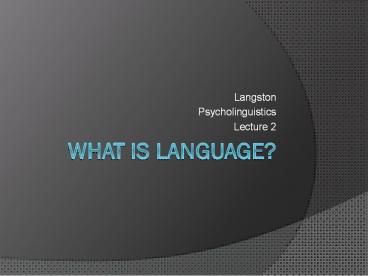What is language? - PowerPoint PPT Presentation
Title:
What is language?
Description:
Langston Psycholinguistics Lecture 2 * What is language? We can define it by its properties. This list is pretty common (Hockett, 1966): 1. Rapid Fading: 2. – PowerPoint PPT presentation
Number of Views:47
Avg rating:3.0/5.0
Title: What is language?
1
What is language?
- Langston
- Psycholinguistics
- Lecture 2
2
What is language?
- We can define it by its properties. This list is
pretty common (Hockett, 1966) - 1. Rapid Fading
- 2. Interchangeability
- 3. Feedback
- 4. Semanticity
- 5. Arbitrariness
- 6. Discreteness
- 7. Displacement
3
What is language?
- We can define it by its properties. This list is
pretty common (Hockett, 1966) - 8. Productivity
- 9. Cultural transmission
- 10. Duality (of Patterning)
- 11. Prevarication
- 12. Reflexiveness
- 13. Learnability
4
What is language?
- If it helps, here's one list of these
- http//www.ling.ohio-state.edu/swinters/371/desig
nfeatures.html
5
(No Transcript)
6
What is language?
- Note that it is kind of arbitrary to rule out
animal communication systems on the basis of this
list since it was developed to distinguish
between human language and animal communication.
(Rx)
7
What is language?
- Another thing about this list is that if you look
around you see people claiming that certain
features are the ones that matter, but they
tend to have different lists. (Rx)
8
What is language?
- We are going to consider language as
rule-described (contrasted to rule-governed).
We'd like to see in the descriptions - Grammar
- A set of elements
- Rules for combining those elements
9
What is language?
- A good grammar
- Simpler is better.
- Should conform to users' intuitions about
language - John kicked the ball.
- The ball was kicked by John.
- Rules should apply to many languages.
10
What is language?
- We can think of grammars for
- Phonology.
- Morphology.
- Syntax.
- Semantics.
- Pragmatics.
11
Grammar Fallacies
- 1. Only some languages have a grammar.
- The ball kicked the boy.
- The boy kicked the ball.
12
Grammar Fallacies
- 1. Only some languages have a grammar.
- Warlpiri (Pinker, 2000, p.232)
- This man speared a kangaroo.
- Man this kangaroo speared.
- Man kangaroo speared this.
- Man speared kangaroo this
13
Grammar Fallacies
- 2. Some grammars are primitive.
- French versus English
- Le livre, les livres
- The book, the books
14
Grammar Fallacies
- 3. People must be taught the grammatical rules of
language. - We've addressed this one.
15
Grammar Fallacies
- 4. Grammatical rules are logical.
- I don't have nothing.
- Yo no tengo nada.
- Tree trees
- Book books
- Sheep sheeps
16
Grammar Fallacies
- 5. Grammars deteriorate with the passage of time.
- We've discussed this, it's more a matter of
evolution than deterioration, and these concerns
are not about the fundamentals but the paint.
17
Grammar Fallacies
- 6. Grammars differ in unpredictable ways.
- Not Pat is here.
- Pat not is here.
- Pat is not here.
- Pat is here not.
- a and d are very rare.
18
Grammar Fallacies
- 6. Grammars differ in unpredictable ways.
- Dogs like bones (SVO).
- Dogs bones like (SOV).
- Like dogs bones (VSO).
- Like bones dogs (VOS).
- Bones like dogs (OVS).
- Bones dogs like (OSV).
- Most a-c, some d and e, none use f for dominant
form.
19
The End































